Seasonal Variation of Indoor Radon Concentration Levels in Different Premises of a University Building
Abstract
1. Introduction
2. Experimental Methods
2.1. Description of the Building Location and Premises
2.2. Measurements of Environmental Parameters and Indoor Radon Concentrations
2.3. Statistical Analysis
- n—the number of pairs (n = 8),
- x—the monthly value of environmental variable,
- —the mean value of environmental variable of the study period,
- y—the monthly indoor radon value, and
- —the mean indoor radon value of the study period.
- n—the number of pairs (n = 8), and
- R—the correlation coefficient.
3. Results and Discussion
3.1. Variations of Monthly Indoor Radon Concentrations
3.2. The Dependence of the Indoor Radon Concentrations on the Outdoor Temperature, Indoor Temperature, and Indoor–Outdoor Temperature Difference
3.3. The Dependencies of the Indoor Radon Concentrations on the Outdoor and Indoor Relative Humidity
3.4. The Dependence of the Indoor Radon Concentrations on the Outdoor and Indoor Pressure
4. Conclusions
Author Contributions
Funding
Conflicts of Interest
References
- Francisco, P.W.; Gloss, S.; Wilson, J.; Rose, W.; Sun, Y.; Dixon, S.L.; Breysse, J.; Tohn, E.; Jacobs, D.E. Radon and moisture impacts from interventions integrated with housing energy retrofits. Indoor Air 2020, 30, 147–155. [Google Scholar] [CrossRef] [PubMed]
- Jasaitis, D.; Girgždys, A. The investigation of tobacco smoke influence on the changes of indoor radon and its short-lived decay products volumetric activities. J. Environ. Eng. Landsc. Manag. 2013, 21, 59–66. [Google Scholar] [CrossRef]
- Gillmore, G.K.; Phillips, P.S.; Denman, A.R. The effects of geology and the impact of seasonal correction factors on indoor radon levels: A case study approach. J. Environ. Radioact. 2005, 84, 469–479. [Google Scholar] [CrossRef] [PubMed]
- Konstantinova, M.; Prokopčiuk, N.; Gudelis, A.; Butkus, D. Radiological assessment of ionizing radiation impact on the terrestrial non-human biota in Lithuania. J. Environ. Eng. Landsc. Manag. 2015, 23, 295–301. [Google Scholar] [CrossRef][Green Version]
- Martins, L.M.O.; Pereira, A.J.S.C.; Oliveira, A.S.; Fernandes, L.F.S.; Pacheco, F.A.L. A new radon prediction approach for an assessment of radiological potential in drinking water. Sci. Total Environ. 2020, 712, 136427. [Google Scholar] [CrossRef] [PubMed]
- Ladygienė, R.; Orentienė, A.; Žukauskienė, L. Investigation into 137Cs found in the soil profile within Vilnius region and estimation of inhabitants exposed to 137Cs transfered through the food chain. J. Environ. Eng. Landsc. Manag. 2012, 20, 213–220. [Google Scholar] [CrossRef]
- Rizo Maestre, C.; Echarri-Iribarren, V.; Galiano-Garrigós, A. Ventilation as an Indispensable Tool for Healthy Constructions: Comparison of Alicante’s Urban Railway Tunnels. Sustainability 2019, 11, 6205. [Google Scholar] [CrossRef]
- Chad-Umoren, Y.E.; Briggs-Kamara, M.A. Environmental ionizing radiation distribution in Rivers State, Nigeria. J. Environ. Eng. Landsc. Manag. 2010, 18, 154–161. [Google Scholar] [CrossRef]
- Bossew, P.; Lettner, H. Investigations on indoor radon in Austria, Part 1: Seasonality of indoor radon concentration. J. Environ. Radioact. 2007, 98, 329–345. [Google Scholar] [CrossRef]
- Papaefthymiou, H.; Mavroudis, A.; Kritidis, P. Indoor radon levels and influencing factors in houses of Patras, Greece. J. Environ. Radioact. 2003, 66, 247–260. [Google Scholar] [CrossRef]
- Ramola, R.C.; Kandari, M.S.; Negi, M.S.; Choubey, V.M. A Study of Diurnai Variation of Indoor Radon Concentrations. Jpn. J. Heal. Phys. 2000, 35, 211–216. [Google Scholar] [CrossRef]
- Maestre, C.; Iribarren, V. The Importance of Checking Indoor Air Quality in Underground Historic Buildings Intended for Tourist Use. Sustainability 2019, 11, 689. [Google Scholar] [CrossRef]
- Karpińska, M.; Mnich, Z.; Kapała, J. Seasonal changes in radon concentrations in buildings in the region of northeastern Poland. J. Environ. Radioact. 2004, 77, 101–109. [Google Scholar] [CrossRef] [PubMed]
- Gallelli, G.; Panatto, D.; Lai, P.; Orlando, P.; Risso, D. Relevance of main factors affecting radon concentration in multi-storey buildings in Liguria (Northern Italy). J. Environ. Radioact. 1998, 39, 117–128. [Google Scholar] [CrossRef]
- Porstendorfer, J.; Butterweck, G.; Reineking, A. Daily Variation of the Radon Concentration Indoors and Outdoors and the Influence of Meteorological Parameters. Health Phys. 1994, 67, 283–287. [Google Scholar] [CrossRef]
- Andersen, C.E.; Søgaard-Hansen, J.; Majborn, B. Soil Gas and Radon Entry into a Simple Test Structure: Comparison of Experimental and Modelling Results. Radiat. Prot. Dosim. 1994, 56, 151–155. [Google Scholar] [CrossRef]
- Keskikuru, T.; Kokotti, H.; Lammi, S.; Kalliokoski, P. Effect of various factors on the rate of radon entry into two different types of houses. Build. Environ. 2001, 36, 1091–1098. [Google Scholar] [CrossRef]
- Hubbard, L.M.; Hagberg, N.; Enflo, A. Temperature Effect on Radon Dynamics in Two Swedish Dwellings. Radiat. Prot. Dosim. 1992, 45, 381–386. [Google Scholar] [CrossRef]
- Akbari, K.; Mahmoudi, J.; Ghanbari, M. Influence of indoor air conditions on radon concentration in a detached house. J. Environ. Radioact. 2013, 116, 166–173. [Google Scholar] [CrossRef]
- Denman, A.R.; Crockett, R.G.M.; Groves-Kirkby, C.J.; Phillips, P.S.; Gillmore, G.K.; Woolridge, A.C. The value of Seasonal Correction Factors in assessing the health risk from domestic radon—A case study in Northamptonshire, UK. Environ. Int. 2007, 33, 34–44. [Google Scholar] [CrossRef]
- Xie, D.; Liao, M.; Kearfott, K.J. Influence of environmental factors on indoor radon concentration levels in the basement and ground floor of a building—A case study. Radiat. Meas. 2015, 82, 52–58. [Google Scholar] [CrossRef]
- Shaikh, A.; Ramachandran, T.; Vinod Kumar, A. Monitoring and modelling of indoor radon concentrations in a multi-storey building at Mumbai, India. J. Environ. Radioact. 2003, 67, 15–26. [Google Scholar] [CrossRef]
- Kitto, M.E. Interrelationship of indoor radon concentrations, soil-gas flux, and meteorological parameters. J. Radioanal. Nucl. Chem. 2005, 264, 381–385. [Google Scholar] [CrossRef]
- Aquilina, N.J.; Fenech, S. The Influence of Meteorological Parameters on Indoor and Outdoor Radon Concentrations: A Preliminary Case Study. J. Environ. Pollut. Control 2019, 2, 1–8. [Google Scholar]
- Baeza, A.; García-Paniagua, J.; Guillén, J.; Montalbán, B. Influence of architectural style on indoor radon concentration in a radon prone area: A case study. Sci. Total Environ. 2018, 610–611, 258–266. [Google Scholar] [CrossRef]
- Oikawa, S.; Kanno, N.; Sanada, T.; Abukawa, J.; Higuchi, H. A survey of indoor workplace radon concentration in Japan. J. Environ. Radioact. 2006, 87, 239–245. [Google Scholar] [CrossRef]
- Rahman, S.U.; Rafique, M.; Matiullah, S.; Anwar, J. Radon measurement studies in workplace buildings of the Rawalpindi region and Islamabad Capital area, Pakistan. Build. Environ. 2010, 45, 421–426. [Google Scholar] [CrossRef]
- Bucci, S.; Pratesi, G.; Viti, M.L.; Pantani, M.; Bochicchio, F.; Venoso, G. Radon in workplaces: First results of an extensive survey and comparison with radon in homes. Radiat. Prot. Dosim. 2011, 145, 202–205. [Google Scholar] [CrossRef]
- Clouvas, A.; Xanthos, S. Antonopoulos-Domis, M. Pilot study of indoor radon in Greek workplaces. Radiat. Prot. Dosim. 2007, 124, 68–74. [Google Scholar] [CrossRef]
- Marley, F.; Denman, A.R.; Phillips, P.S. Studies of Radon and Radon Progeny in Air Conditioned Rooms in Hospitals. Radiat. Prot. Dosim. 1998, 76, 273–276. [Google Scholar] [CrossRef]
- Mnich, Z.; Karpińska, M.; Kapała, J.; Kozak, K.; Mazur, J.; Birula, A.; Antonowicz, K. Radon concentration in hospital buildings erected during the last 40 years in Białystok, Poland. J. Environ. Radioact. 2004, 75, 225–232. [Google Scholar] [CrossRef] [PubMed]
- Banjanac, R.; Dragic, A.; Grabez, B.; Jokovic, D.; Markushev, D.; Panic, B.; Udovicic, V.; Anicin, I. Indoor radon measurements by nuclear track detectors: Applications in secondary schools. Facta Univ. Ser. Phys. Chem. Technol. 2006, 4, 93–100. [Google Scholar] [CrossRef]
- Bahtijari, M.; Stegnar, P.; Shemsidini, Z.; Ajazaj, H.; Halimi, Y.; Vaupotič, J.; Kobal, I. Seasonal variation of indoor air radon concentration in schools in Kosovo. Radiat. Meas. 2007, 42, 286–289. [Google Scholar] [CrossRef]
- ISO 11665-1:2019. Measurement of Radioactivity in the Environment—Air: Radon-222—Part 1: Origins of Radon and Its short-Lived Decay Products and Associated Measurement Methods. Available online: https://www.iso.org/obp/ui/#iso:std:iso:11665:-1:ed-2:v1:en (accessed on 15 July 2020).
- ISO 11665-5:2020. Measurement of Radioactivity in the Environment—Air: Radon-222—Part 5: Continuous Measurement Methods of the Activity Concentration. Available online: https://www.iso.org/standard/76010.html (accessed on 15 July 2020).
- Mukaka, M.M. A guide to appropriate use of correlation coefficient in medical research. Malawi Med. J. 2012, 24, 69–71. [Google Scholar]
- Council Directive 2013/59/Euratom of 5 December 2013 Laying Down Basic Safety Standards for Protection Against the Dangers Arising from Exposure to Ionising Radiation, and Repealing Directives 89/618/Euratom, 90/641/Euratom, 96/29/Euratom, 97/43/Euratom and 2003/122/Euratom. Available online: https://eur-lex.europa.eu/eli/dir/2013/59/oj (accessed on 15 July 2020).
- Stojanovska, Z.; Januseski, J.; Bossew, P.; Zunic, Z.S.; Tollefsen, T.; Ristova, M. Seasonal indoor radon concentration in FYR of Macedonia. Radiat. Meas. 2011, 46, 602–610. [Google Scholar] [CrossRef]
- Symonds, P.; Rees, D.; Daraktchieva, Z.; McColl, N.; Bradley, J.; Hamilton, I.; Davies, M. Home energy efficiency and radon: An observational study. Indoor Air 2019, 29, 854–864. [Google Scholar] [CrossRef]
- Meyer, W. Impact of constructional energy-saving measures on radon levels indoors. Indoor Air 2019, 29, 680–685. [Google Scholar] [CrossRef]
- Rowe, J.E.; Kelly, M.; Price, L.E. Weather system scale variation in radon-222 concentration of indoor air. Sci. Total Environ. 2002, 284, 157–166. [Google Scholar] [CrossRef]
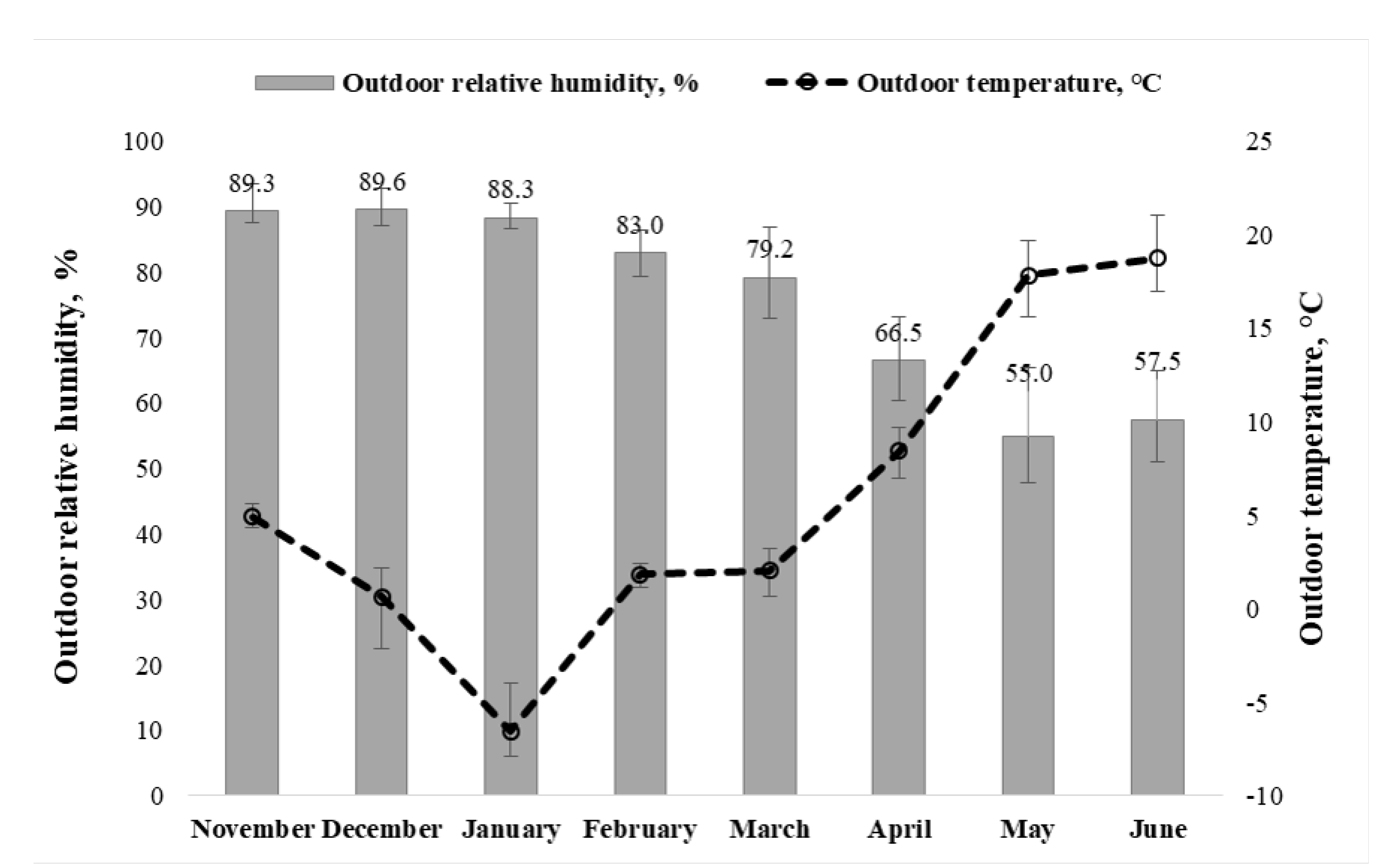

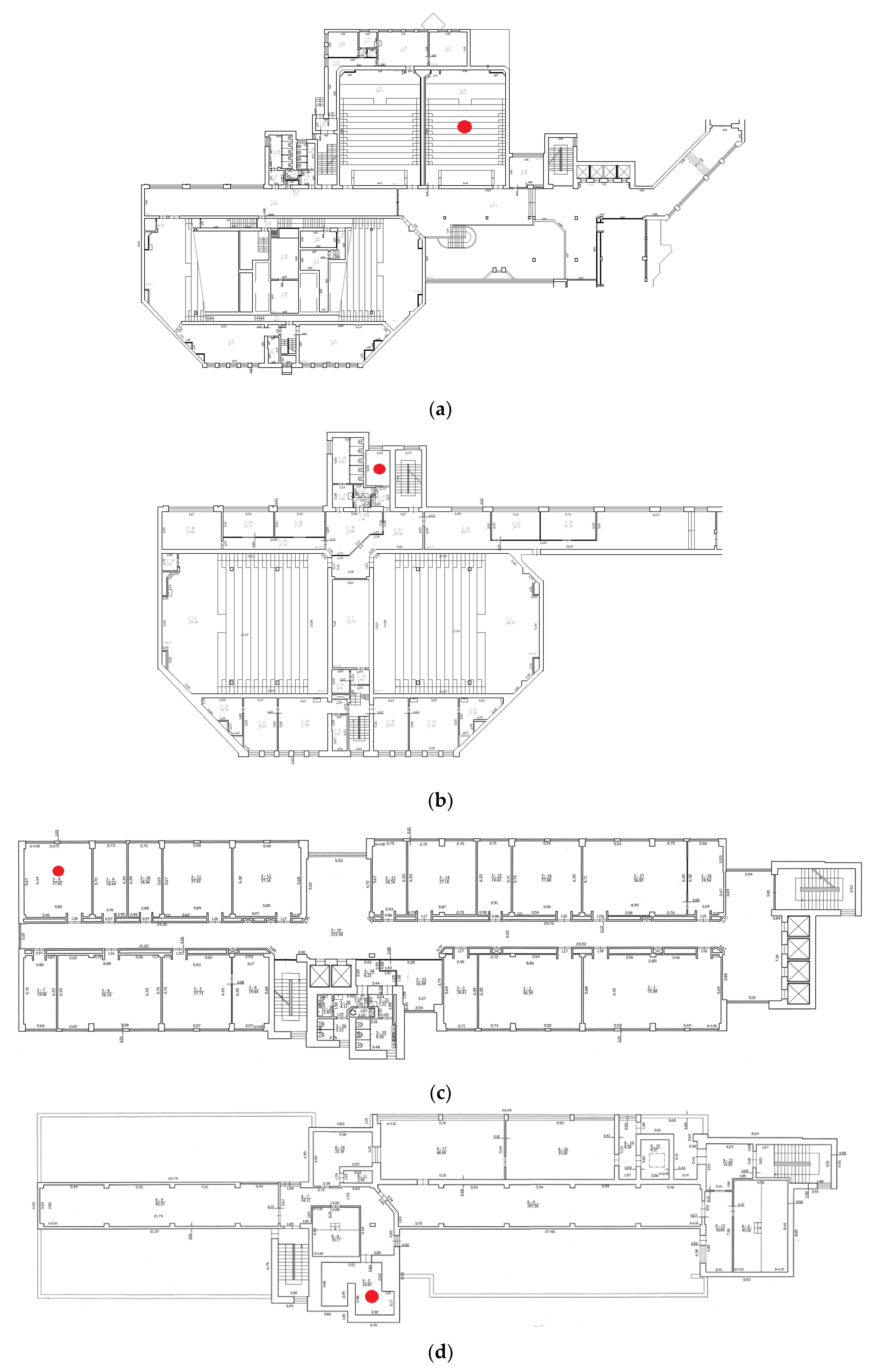

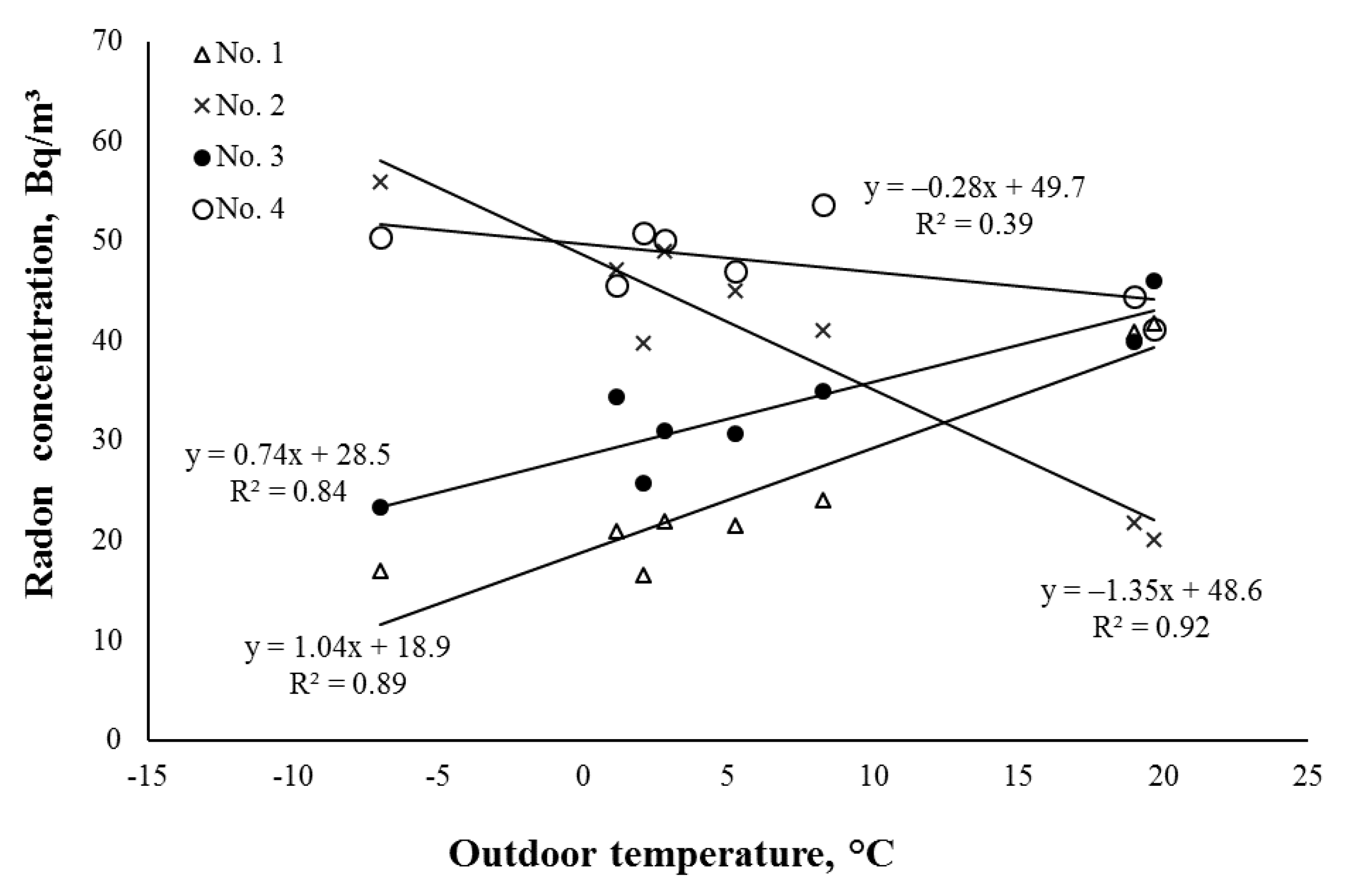


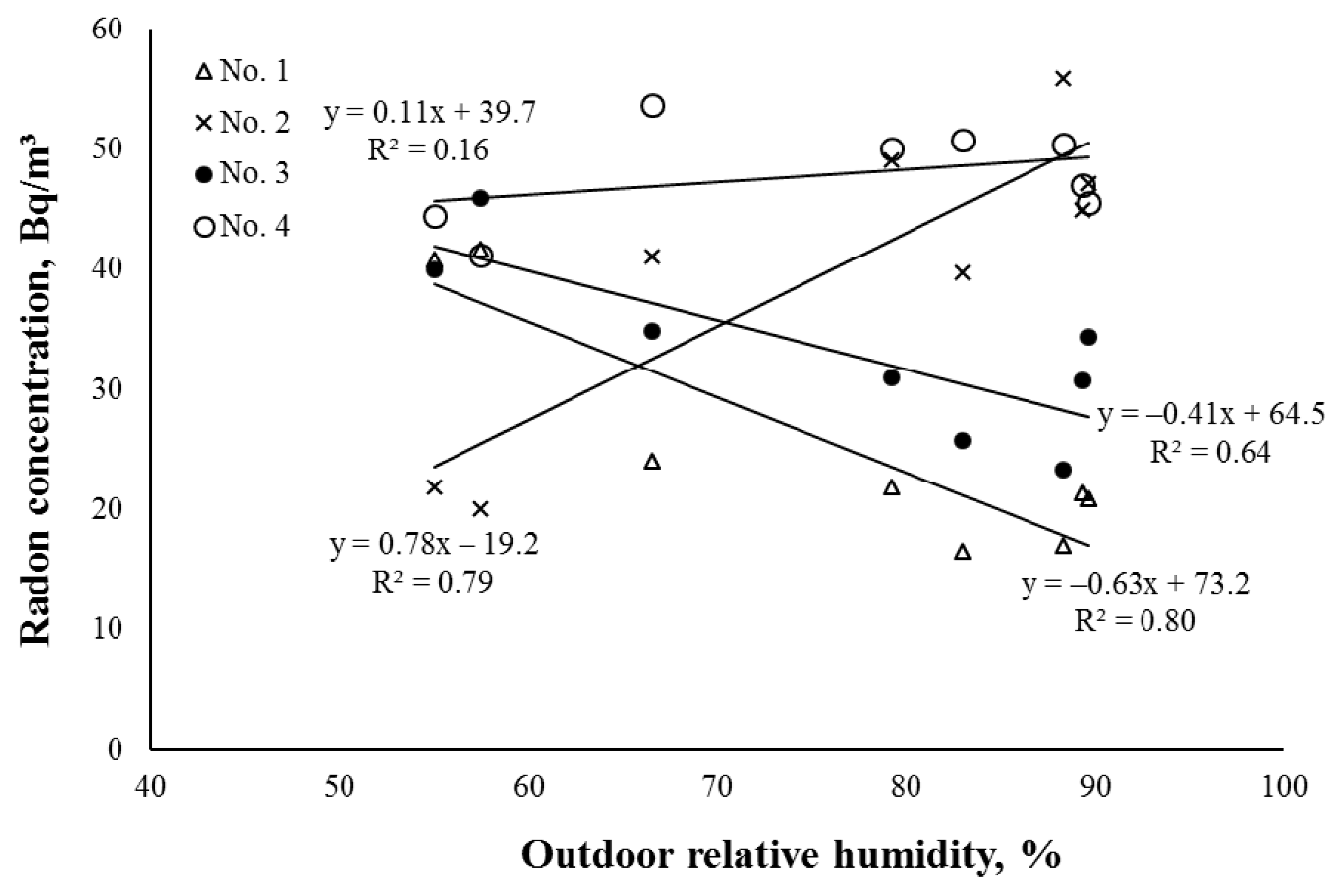
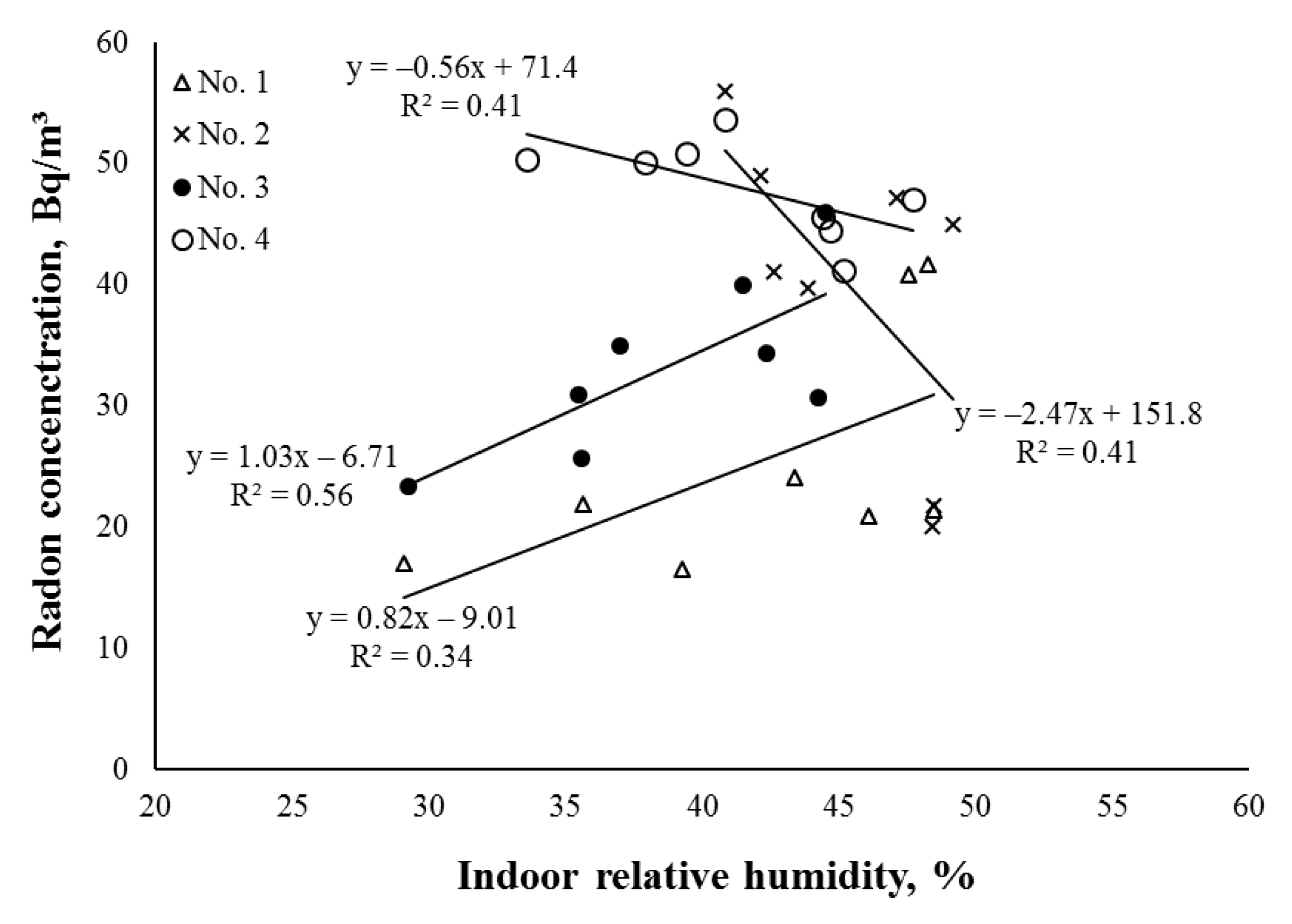
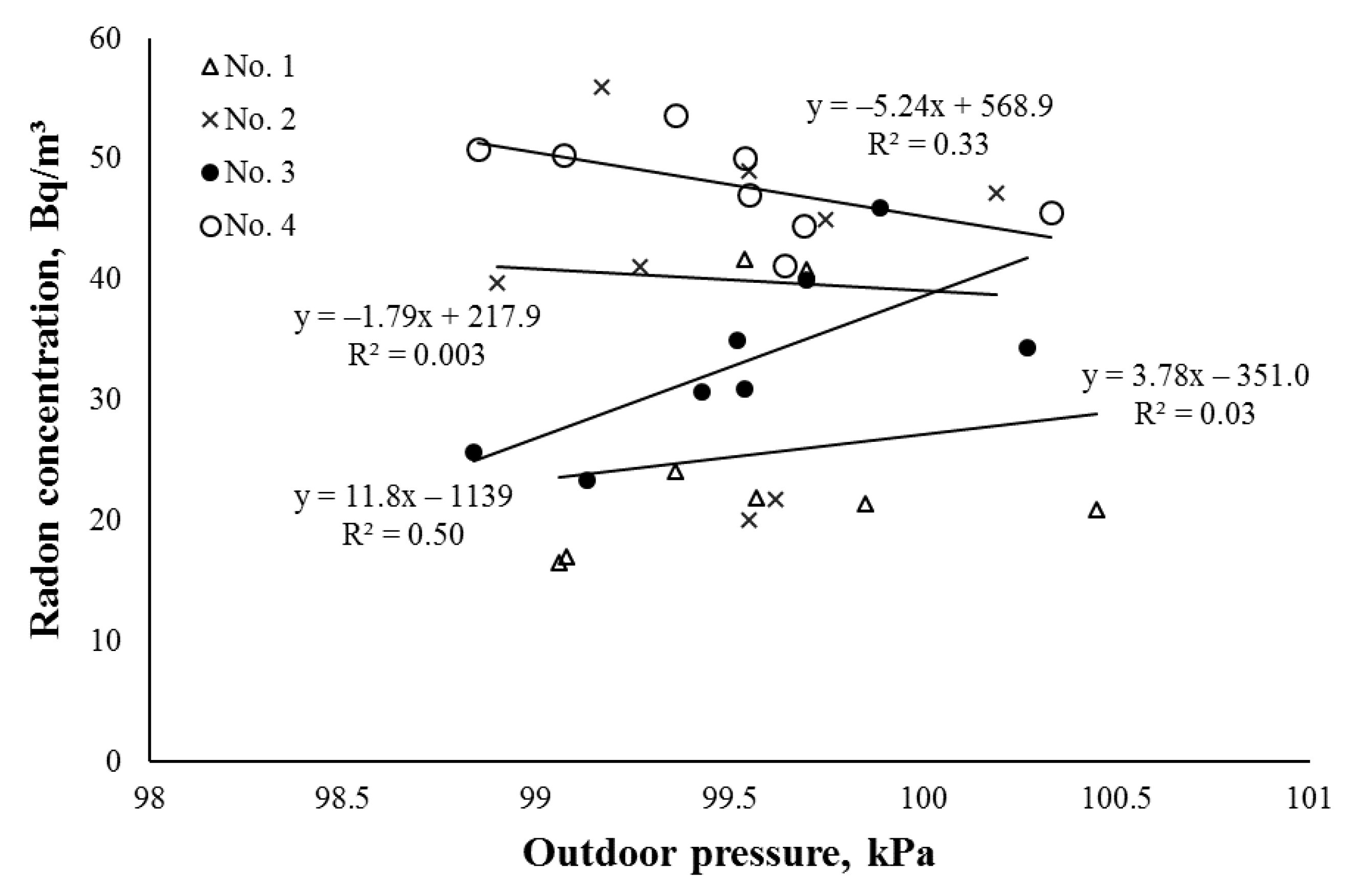
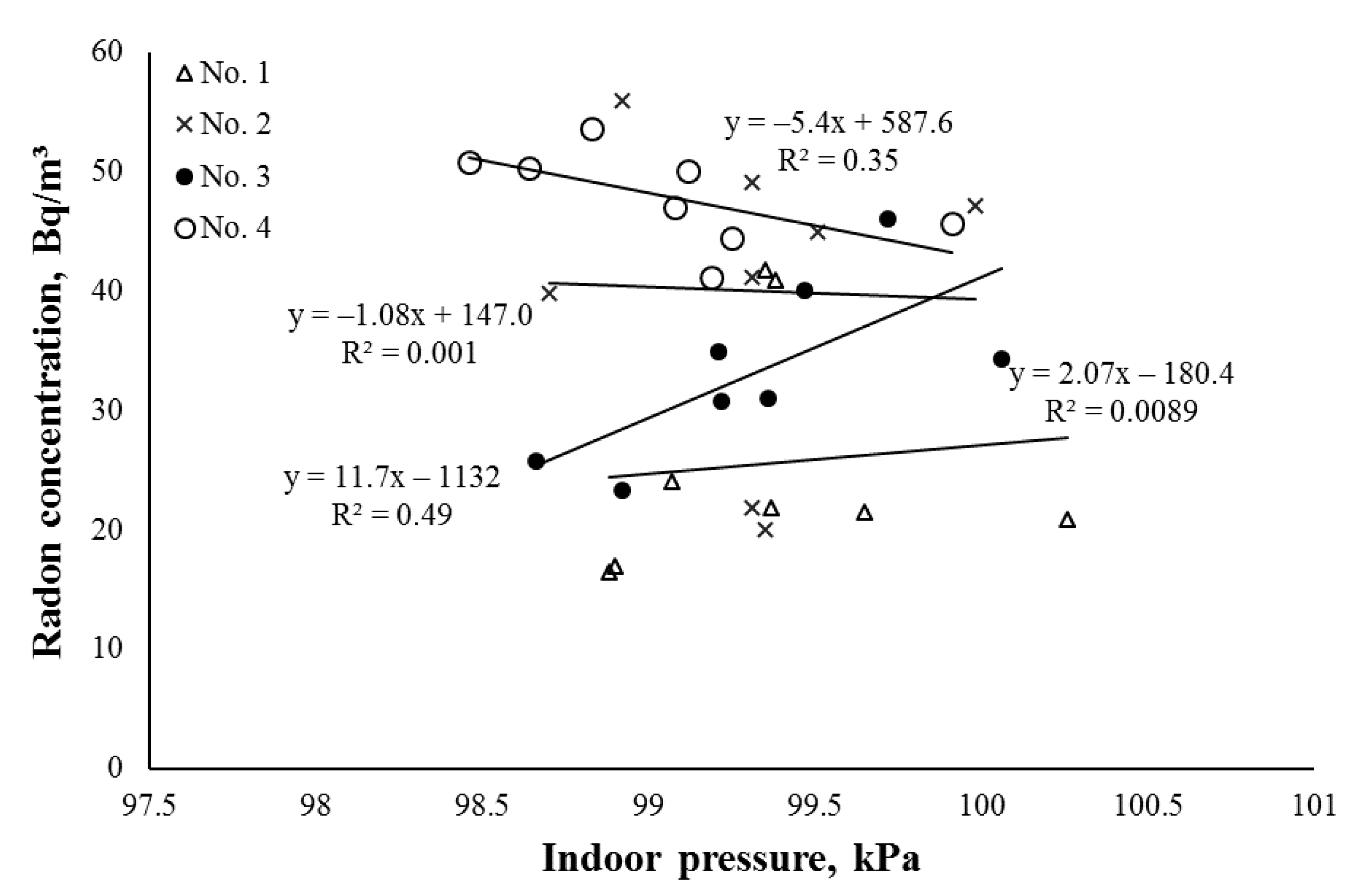
| Premises | The Premises Floor | Cubic Volume, m3 | Type of Ventilation | The Purpose of Premises |
|---|---|---|---|---|
| No. 1 | Second | 680.7 | Natural and forced convection | Auditory premises |
| No. 2 | Third | 25.65 | Natural convection | Various laboratory equipment storage place |
| No. 3 | Fourth | 100.4 | Natural convection | Laboratory premises |
| No. 4 | Ninth | 67.0 | Natural convection | Old laboratory equipment storage place |
| Month | Radon Concentration in the Premises, Bq/m3 | |||
|---|---|---|---|---|
| No. 1 (Second Floor) | No. 2 (Third Floor) | No. 3 (Fourth Floor) | No. 4 (Ninth Floor) | |
| November 2018 | 21.5 ± 5.7 | 45.0 ± 17.6 | 30.7 ± 10.1 | 47.1 ± 13.8 |
| December 2018 | 20.9 ± 8.2 | 47.2 ± 16.1 | 34.4 ± 11.9 | 45.6 ± 18.2 |
| January 2019 | 17.0 ± 5.0 | 55.9 ± 20.1 | 23.4 ± 8.1 | 50.4 ± 18.9 |
| February 2019 | 16.5 ± 5.4 | 39.9 ± 12.7 | 25.7 ± 9.9 | 50.8 ± 19.7 |
| March 2019 | 21.9 ± 7.3 | 49.0 ± 18.3 | 31.0 ± 9.3 | 50.1 ± 18.3 |
| April 2019 | 24.0 ± 8.5 | 41.1 ± 17.2 | 34.9 ± 9.6 | 53.7 ± 17.6 |
| May 2019 | 40.9 ± 13.9 | 21.9 ± 7.2 | 40.2 ± 9.9 | 44.5 ± 13.6 |
| June 2019 | 41.8 ± 14.3 | 20.1 ± 8.3 | 46.1 ± 17.3 | 41.2 ± 14.7 |
| Average | 25.6 | 40.0 | 33.3 | 47.9 |
© 2020 by the authors. Licensee MDPI, Basel, Switzerland. This article is an open access article distributed under the terms and conditions of the Creative Commons Attribution (CC BY) license (http://creativecommons.org/licenses/by/4.0/).
Share and Cite
Baltrėnas, P.; Grubliauskas, R.; Danila, V. Seasonal Variation of Indoor Radon Concentration Levels in Different Premises of a University Building. Sustainability 2020, 12, 6174. https://doi.org/10.3390/su12156174
Baltrėnas P, Grubliauskas R, Danila V. Seasonal Variation of Indoor Radon Concentration Levels in Different Premises of a University Building. Sustainability. 2020; 12(15):6174. https://doi.org/10.3390/su12156174
Chicago/Turabian StyleBaltrėnas, Pranas, Raimondas Grubliauskas, and Vaidotas Danila. 2020. "Seasonal Variation of Indoor Radon Concentration Levels in Different Premises of a University Building" Sustainability 12, no. 15: 6174. https://doi.org/10.3390/su12156174
APA StyleBaltrėnas, P., Grubliauskas, R., & Danila, V. (2020). Seasonal Variation of Indoor Radon Concentration Levels in Different Premises of a University Building. Sustainability, 12(15), 6174. https://doi.org/10.3390/su12156174





